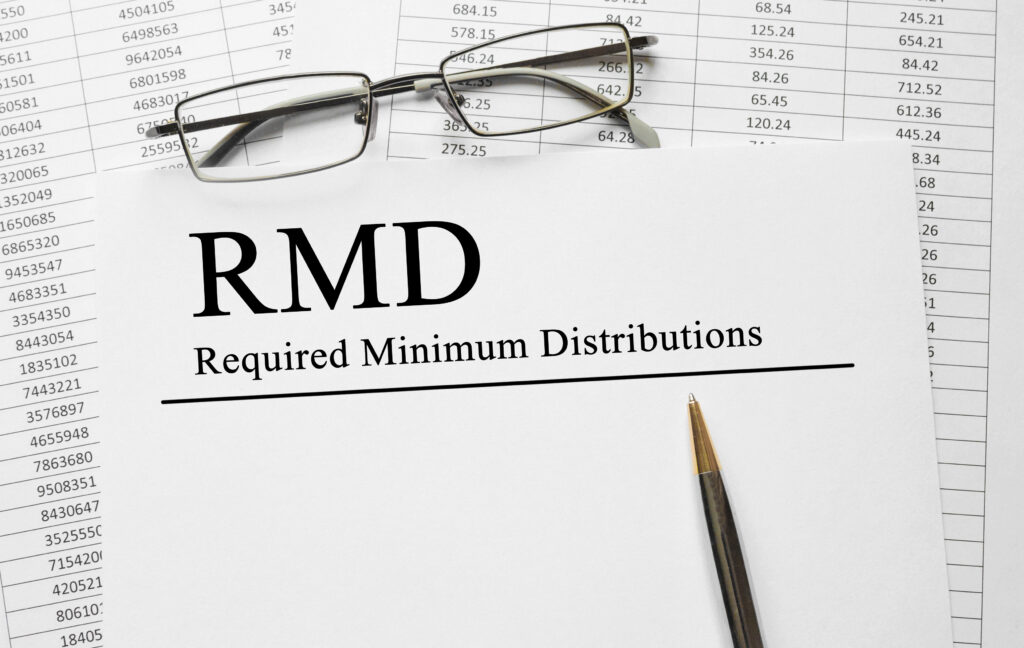Navigating Required Minimum Distributions

Congrats, you made it! You worked hard and successfully retired, and you haven’t even needed to touch the money in your 401(k) account. However, you have heard about RMDs and aren’t sure what they are and if they are relevant to you. So, what exactly is a RMD?
What is a RMD?
A required minimum distribution (RMD) is the money that you must take out of certain employer sponsored plans (traditional 401(k), SEP IRA, SIMPLE IRA) or a traditional IRA. RMDs must be taken out by the April 1st after you’ve turned 73 or you must pay a 25% penalty on the amount not withdrawn. After your first RMD, all future RMDs need to be taken by December 31st of the corresponding year.
Why RMDs Exist
Required minimum distributions exist because the government makes a deal with anyone using a traditional account. Traditional retirement accounts allow the contributor to defer taxes. What this means is you don’t have to pay taxes when the money goes into the account, but you must pay taxes when you withdraw money. Required minimum distributions ensure that people pay their deferred tax liability. Roth 401(k)s and Roth IRAs do not have required minimum distributions. This is because with Roth accounts, you pay the taxes when you contribute to the account to receive tax-free withdrawals.
Calculating your RMD Amount
Understanding the amount of your RMD takes a little math. In most cases, the custodian who holds your account will run the calculation for you and let you know the amount of your required minimum distribution. However, in the case that they don’t provide the amount, you can find your RMD amount by following the steps below:
- Find your account balance as of December 31st of last year.
- Look up your age and distribution factor on the IRS’ uniform lifetime table III
- Note: If your spouse is the sole beneficiary and is 10 years younger, use table II
- Divide your account balance by the distribution factor corresponding to your age
Ex. Account balance on December 31st is $100k and Fred is 85. $100k/16. Fred’s RMD is $6,250.
If you have multiple IRAs or traditional 401(k)s, you will need to calculate the RMD amount for each account.
RMDs for Inherited Retirement Accounts
Required minimum distributions are slightly different when it comes to inherited individual retirement accounts, and there were changes to the inherited IRA RMD requirements with the SECURE Act. An inherited individual retirement account is an account that is created for the beneficiary of the deceased’s account. If you are an eligible designated beneficiary, you have more flexibility in how you can access the funds and could potentially avoid the RMDs. To qualify as an eligible designated beneficiary, you must be:
- Spouse or minor child of the deceased account holder
- Disabled or chronically ill individual
- Individual who is not more than 10 years younger than the IRA owner or plan participant
Spouses have the most flexibility in how they want to receive the funds in the inherited IRA. If the account owner passed away before they started taking RMDs, the spouse can choose to delay the RMDs until the deceased spouse would have turned 72, take RMDs based on their own life expectancy, follow the 10-year rule, or roll over the account into their own IRA. If the deceased spouse was already taking RMDs, then the spouse can take RMDs based on their own life expectancy or roll over the account into their own IRA.
Other eligible designated beneficiaries can choose to take the required minimum distributions over the longer of their own life expectancy or the employee’s remaining life expectancy or follow the 10-year rule.
For any beneficiary who is not an eligible designated beneficiary, they must follow the 10-year rule. The 10-year rule means that all the funds in the account must be distributed within 10 years. In 2022, the IRS proposed rules to require beneficiaries of inherited traditional IRAs following the 10-year rule to make a RMD every year based on their own life expectancy until the 10th year which all the remaining funds need to be distributed. The IRS has waived this requirement for 2024, but it is still a restriction to consider for the future. If you have inherited a Roth IRA instead, you do not have required minimum distributions each year. Instead, you could wait until the 10th year, and then distribute all the funds.
Calculating the RMD for an inherited account is identical to the calculation listed above for your own traditional accounts, except instead of using the uniform life table III, you use the single life expectancy table I.
Note: The requirements in this section are assuming that the death of the account owner occurred in 2020 or later. If the account owner passed before 2020, this IRS publication shows the available distribution options.
Tax Implications on RMDs
Taxes paid on required minimum distributions are primarily going to be determined by if the retirement account was designated as traditional or as Roth. If the deceased’s account was a Roth and it was open for at least 5 years, then there will be no taxes due on the required minimum distributions. However, if it was a traditional account, then the RMDs will be taxed as ordinary income. This can be problematic for people who are at the top of a tax bracket as the RMD could push them into a higher tax bracket, causing the distribution to be taxed at a higher rate. Creating a strategy around RMDs and properly managing your tax bracket can help ensure that you keep your overall tax bill lower than just taking a RMD.
Navigating RMDs can be tricky and not taking them properly can end up costing you in penalties. Working with a financial planner early in retirement can help you have a plan in place to avoid costly penalties and if relevant, avoid RMDs altogether. If you have any questions on how to best prepare your family for the future, one of our advisors would be happy to help!
Similar Articles
Business Owner


